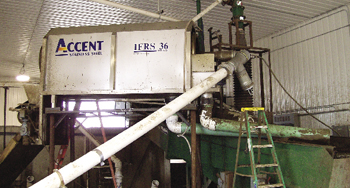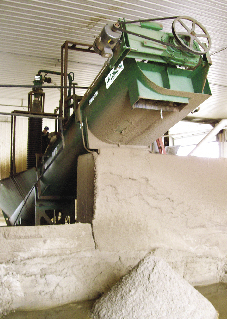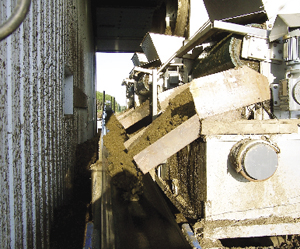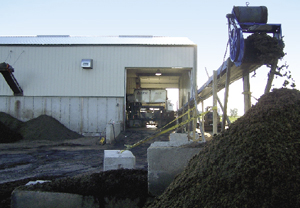
Minnesota dairy Alpha Foods found
a McLanahan/Accent separator combination, used on a contract basis at
the farm, to be a good solution to a lagoon build-up problem, with the
equipment combo also proving to be a very effective sand separation
solution.
 |
Minnesota dairy Alpha Foods found a McLanahan/Accent separator combination, used on a contract basis at the farm, to be a good solution to a lagoon build-up problem, with the equipment combo also proving to be a very effective sand separation solution.
A project that started out as a lagoon in need of dredging also led to the successful tryout of a new separation system for Minnesota-based dairy Alpha Foods.
Alpha Foods had inherited a 12-million-gallon lagoon when it purchased an 80-acre farm three years ago. Between the build-up from the previous owners and the solids introduced by Alpha Food’s 1,350-head dairy operation, the lagoon needed to be dredged. They turned to the experts — R Way Pumping and Hydro Engineering — to take care of it.
The lagoon had a number of issues. “The solid material was thick and needed to be pumped about 800 feet for processing. In addition, because there was so much solid material in the lagoon, it was going to take a lot of water to get it out. Plus, the dairy had switched to sand bedding, and sand was going to make it even harder to pump,” explains John George of Hydro Engineering. “So Roger Becker of R Way Pumping and I brainstormed and came up with an alternative. We’d dredge the lagoon and put the material through an Accent separator, take the solids out and remove the sand, and then return the water back to the lagoon with very little solids left. We would reduce the cost because we wouldn’t be handling the liquid, just the solids from the lagoon bottom.”
This wasn’t a new idea; others had tried this before with limited success. But George and Becker both felt that technology was now available to make it possible — namely Accent separators.
George drew up a plan for the new dredging system and put together an Accent demo unit, which he and Becker took to the farm to test. “We hooked up a Houle lagoon pump and lowered it down into the lagoon. We were pumping off the bottom, pulling up the stuff that had been in the lagoon for quite a while,” says George. “As expected, it wouldn’t separate, so we tried moving the pump up and down, running it as it dropped through the entire sludge layer.”
The “lifting and dropping” worked. The fibrous materials on top, mixed with the bottom material, produced a mixture that was easily separated by the Accent. The trial was a success.
Using what was learned and a modified dredge, the process began in earnest. A six-inch hose took the material from the dredge to a rock catcher and then on to three Accent IFRS (internally fed rotary screen) 36 separators. “Once separated, the solids were stockpiled via conveyors,” says George. “The liquid went from the Accents to the farm’s McLanahan separator to remove the sand.”
 The liquid went from the Accents to the farm’s McLanahan separator for sand removal. The liquid went from the Accents to the farm’s McLanahan separator for sand removal. |
Once the bugs were worked out, R Way Pumping and Hydro Engineering were averaging 780 gallons a minute — removing anywhere from 35 to 45 cubic yards an hour of solids. Nick Ridgeway, manager of Alpha Foods, says that when all was said and done, “they had removed over 6,000 tons of solids, which were conveyered out to an outside slab.”
During the test, they were pleased to find that once the fiber was ripped away by the Accent separators, the sand would remain with the liquids. “It just seemed to work that way,” says George. “The Accent allows the sand and water to travel together from the separator, and once you close the velocity of water down, the sand automatically drops out. And it’s reusable sand.”
The separation system worked so well for dredging that Ridgeway wanted to try, on a contract basis, incorporating the Accents into the separation system they already had on the farm. The existing system used a Vac Truck to pick up the sand-laden material from the free stalls and then moved it into a 20-foot by 12-foot cement reception pit. A Houle piston pump took it directly to a McLanahan sand separator.
The McLanahan removed the sand to be reused as bedding. The overflow went into another smaller cement reception pit, eight feet by 15 feet, where it was pumped through a Hydro Cyclone to extract the finer sand. The liquid run-off was fed directly into two existing separators.
 Material Materialwas taken from the dredge to a rock catcher and then on to three Accent IFRS 36 separators. Once separated, the solids were stockpiled, using conveyors. |
“The system required a lot of fresh water,” says Ridgeway. “We were running about 25 gallons a minute with the McLanahan. But the sand was so abrasive, it kept eating the screens on our existing separators.”
To make the system more efficient, the existing separators were replaced, and an Accent IFRS 36 with a 1/8-inch screen was added to separate the solids before they reached the McLanahan.
The Accent ripped the fiber loose, and the solids were conveyered to a slab outside. No fresh water was required because recycled water from the Accent can be used. The overflow from the McLanahan continued on to the Hydro Cyclone and then to the lagoon.
“What is nice about the Accent in the system is that it is variable speed. So we can speed it up or slow it down based on the material we’re getting — to further the separation process. It adds a lot of versatility,” says George. “The adjustable legs on the separator allow you to elevate the discharge end of the unit to hold the material inside the drum longer for more dewatering. Plus it has a CIP (clean in plate) system, so you can clean the drum automatically or manually.”
Ridgeway is impressed with the improvement he saw in the sand separator: “The McLanahan worked wonderfully once the organic matter was removed. And we ended up with a much better quality of sand.”
And although Ridgeway says they weren’t capturing all the sand that they were before, he didn’t mind. “We weren’t reclaiming quite as much, but it was mostly the bigger particles that were slipping through and they’re going out with the manure. The important thing is that they weren’t going into the basin.”
Alpha Foods doesn’t have any problem finding a home for the solids. “I have people waiting for them,” says Ridgeway. “We’ve thought about selling the solids, but most of the nutrient value stays in the liquid from what we can tell. So if people want the solids, they’re free to truck it away.”
And Alpha Foods has also found what seems to be a solution to some of their odor concerns. “We’re only about two miles from Litchfield, Minnesota, and we’re always concerned about odor,” says Ridgeway. “This spring we started adding bacteria called Green Flash to our basin to break down the manure, and that has really reduced our odor. In the past when we’ve agitated, it’s been almost overpowering. But it wasn’t like that this year.”
This entire project has been so successful that Hydro Engineering is working on taking its separation system on the road. It is creating a portable dredging unit that will contain:
• six Accent IFRS 36 separators;
• two cyclones;
• a fresh water tank;
• a generator set to run the unit;
• and a conveyor belt that will discharge solids in a pile or onto a sitting truck.
The entire unit will fit on a 53-foot trailer and be easily transported to farms to help livestock producers, like Alpha Foods, with lagoon issues.
 The system was averaging 780 gallons a minute, removing anywhere from 35 to 45 cubic yards an hour of solids, which were conveyered to an outside slab. The system was averaging 780 gallons a minute, removing anywhere from 35 to 45 cubic yards an hour of solids, which were conveyered to an outside slab. |
“It’s completely self-contained and will allow us to go to a dairy or hog lagoon. And our tests show that the six Accents will allow us to separate upwards of 100 yards an hour,” says George. “We see a real need for this. Lots of people want to use sand because of cow comfort, but it’s very costly. This portable system will solve a lot of material handling issues, reduce abrasion on pumps and produce reusable sand.”
The portable unit will work similarly to the demo unit tested at Alpha Food. As the dredging takes place, the material will be pumped to the Accent separators to remove the fiber. The fiber solids will go onto a conveyor belt and be stockpiled for field application. The sand and water will pass through the Accents to the cyclones. The sand will be removed and the water will be returned to the lagoon.
“It puts a whole new angle on the business,” says George. “New technologies have given us a different perspective and they are giving our customers who are having problems with solids a good alternative.”